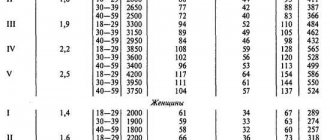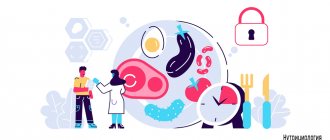Nutrition according to the 8/16 system is one of the most effective methods that help solve the problem of excess weight forever.
A program developed by nutritionists, based on the principle of hunger management, allows you to activate metabolic processes that help cleanse the body of waste and toxins, while simultaneously lowering cholesterol levels and normalizing physical indicators of blood pressure.
What is intermittent fasting?
Intermittent fasting, from English Intermittent Fasting - IF , is a way of temporarily restricting food. This means you need to intentionally reduce your caloric intake (up to 25% of your normal daily calorie intake) for 16 to 24 hours, varying your normal meal times between 8 and 24 hours, depending on your IF type. [35] Unlike other diets, during intermittent fasting you can eat almost anything, but only for a limited time.
The main idea of intermittent fasting is to reduce the amount of calories you consume, which leads to weight and fat loss . This is just one of many ways to lose weight and get rid of belly fat. Refers to simple ways of eating that many people liked. The benefit of intermittent fasting is the fact that such nutrition has healing effects.
Indications for use
Nutrition 8/16 for weight loss is allowed to be practiced only by completely healthy people who are not aging with chronic gastrointestinal diseases. The purpose of following a diet can be either the desire to lose weight by cleansing the body of waste and toxins or the intention to maintain a figure in the required shape.
It is possible to use interval nutrition for atrophic obesity, but it is allowed only in the absence of pathologies associated with the problem, such as diabetes mellitus and thyroid dysfunction.
Types of partial fasting or intermittent fasting
Types of intermittent fasting differ based on the time period during which you do not eat. In the following paragraphs, we will introduce you to the 6 types of intermittent fasting. Each of them may be effective for you. Which type of IF is right for you is determined on a purely individual basis.
16/8 – 16-hour fast
This is the most natural way of eating. 16/8 is a method according to which you fast for 16 hours every day, and during the usual 8 hours you can eat 2, 3 or more servings of food. This fast is known as the Leangains protocol and was made popular by fitness expert Martin Berkan. [9]
Following the 16/8 diet means you skip breakfast and your last meal is dinner. For example, you stop eating at 20:00 in the evening and your next meal will be lunch at 12:00 the next day. You won't notice that you went through a 16-hour fast, including 8 hours of sleep.
You can easily adjust this mode to suit your own needs. If you can't imagine starting the day without a quality breakfast , then you can skip dinner. It is important to keep an eye on the ratio of 14/10 or 16/8.
During fasting, naturally, you need to take in enough liquid to hydrate your body well. You can drink clean water, unsweetened coffee and zero-calorie drinks. During the “nutrition” window, you can normally eat what you were eating before that moment. You will achieve quick results if and healthy dishes to your diet But intermittent fasting will not work if during 8 hours you eat as much as if you were trying to fill 16 hours of fasting . The golden rule still applies, consume as much as you can burn during the day.
The Warrior Diet
The Warrior Diet , developed by Orim Hofmekler, is another type of 20/4 intermittent fasting. During the 20 hours you are on a fast, and you can eat for 4 hours a day . The goal of the war diet is to increase the effectiveness of the sympathetic nervous system, which helps stimulate lipolysis and speed up metabolism. [44] Additionally, during 4 hours of eating, you activate the parasympathetic nervous system, which helps increase glucose absorption and regeneration. [45]
You can see the warrior diet and 16/8 charted on the time axis. [5]
5:2 – fast for two days every week
The 5:2 fast consists of 5 days of normal eating and two days of eating 500-600 calories per day. Moreover, men and 500 women can consume 600 calories. The 5:2 diet is also known as the “crash diet” , which was brought to the masses by doctor and journalist, Michelle Mosley. In practice, the 5:2 plan looks like this: for a whole week you eat classic portions , and on Tuesday and Thursday you reduce your calorie intake. This way you only eat 2 small portions containing 250 calories for women and 300 for men. Critics see the downside of this diet as being that it has not been studied enough, even though self-paced intermittent fasting has undergone much research. [9] [5]
Eat-stop-eat – fast for the whole day 1-2 times a week
Eat-stop-eat involves fasting for 24 hours 1 or 2 times a week. This type of intermittent fasting has become quite popular in recent years thanks to fitness expert Brad Pilon.
The eat-stop-eat mode means that you do not eat food from the evening of the first day until the dinner of the second day. Naturally, you can fast from breakfast to breakfast, or from lunch to lunch the next day. The goal is to go 24 hours without eating. You are allowed to drink coffee, water and other low-calorie drinks that will reduce your hunger . If you want to lose weight, it is important that on days when you are not fasting, you eat as much as if you were not on a diet . Attention, we still mean eating healthy and balanced food.
If you are planning to try this diet, we advise you to first test the 14 and 16 hour fast and gradually prepare your body for the day of the fast. If you decide to follow this diet, your diet will look like the picture below. [9] [5]
Alternate-day fasting - fasting every second day
Alternate-day fasting is a way of eating when you fast every second day. There are several versions of this type of intermittent fasting. From a complete fast to being able to eat 500 calories during a fast day.
For example, you eat classically for 12 hours and fast for the next 36 hours, or you can eat for 24 hours and then fast for the next 24 hours. [5] Alternate-day is a very extreme type of fasting, so you should not maintain this diet for a long time. You can see the described mode of this method in the picture. [9]
Random Meal Skipping - random hunger strike
It is not always necessary to follow strict instructions for intermittent fasting . If you do a 24-hour fast , you can experience some of the health benefits of intermittent fasting. The main thing is that people should eat every couple of hours to avoid going into starvation mode and damaging muscle mass. The human body adapts to going several days without food. Therefore, try this diet at times when you don’t feel hungry , on the road, or when you don’t have time to cook. What does this look like in practice? See the approximate diet during a random hunger strike in the attached picture. [5] [9]
Contraindications for use
Doctors unanimously prohibit eating according to the 8/16 system for people suffering from:
- pathologies of the endocrine and cardiovascular systems;
- chronic gastrointestinal dysfunctions;
- various nervous disorders;
- serious pathologies of the kidneys and liver;
- diabetes mellitus (congenital or acquired);
- ulcer, gastritis, cholecystitis, pancreatitis;
- gout;
- hormonal disorders;
- vitamin deficiency;
- oncological diseases;
- tendency to exacerbation of anorexia.
You cannot use any methods of fasting:
- women expecting a child;
- breastfeeding mothers;
- children under 18 years of age;
- teenagers suffering from psychological problems caused by dissatisfaction with their own weight.
Intermittent feeding should be practiced only after consulting a doctor.
In addition, even absolutely healthy people may experience:
- periodic headache;
- bowel problems (constipation or diarrhea);
- stomach pain and heartburn;
- sudden severe attacks of hunger;
- weakness, depression, irritability, decreased performance.
Restriction in nutrition is also fraught with the appearance of symptoms of overeating, caused by the body’s desire to stock up on missing calories for future use. People who are accustomed to not restricting their diet can easily become victims of sudden breakdowns, leading to sudden, repeated weight gain.
Intermittent fasting for athletes
And athletes liked the intermittent fasting diet because during it there is no need to change their training and nutrition regimen. Study participants who adhered to alternate-day fasting confirmed that they were less hungry, more relaxed compared to other diets, and did not need to change their diet. [33]
IF may also increase fatigue in athletes, especially during fasted exercise. But this does not mean that it will reduce your productivity. In fact, during intermittent fasting it is necessary to take supplements to add energy and support regeneration or immunity.
Supplements suitable for intermittent fasting
Here's a list of recommended supplements to maximize your efforts during intermittent fasting. They are divided into supplements during the day, before, during and after training.
1. Nutritional supplements throughout the day
Branched Chain Amino Acids BCAA – A BCAA supplement will help you increase protein synthesis , which will even out some of the proteins that are broken down. You will appreciate this effect if you train on an empty stomach and stick to IF. [34]
2. Before training
- Caffeine – The addition of caffeine will give you that much-needed boost of energy. At 2-5 mg per kg of your weight, you can also increase your upper body strength. [36]
- Beta Alanine – consuming beta alanine has been shown to support performance because it reduces fatigue . This dietary supplement reduces blood acidity levels, which promotes better performance. An effective serving of beta-alanine is 3.2 g to 6.4 g per day. [37]
- Important amino acids and carbohydrates - consuming 6 grams of important amino acids mixed with 35 grams of sucrose immediately before training will significantly increase protein synthesis. It acts this way as a result of a surge of amino acids to active muscles . [38]
3. During training
BCAA supplementation with branched chain amino acids during training occurs in two ways. BCAAs slow down the breakdown of proteins and also help regenerate muscle mass , while protecting against fatigue . The recommended serving is 7 g of BCAA containing 3.5 g of leucine, 1.75 g of isoleucine and 1.75 g of valine, therefore in a ratio of 2:1:1. [39] [40] [41]
4. After training
- Protein – Supplementing with protein post-workout helps maximize the effect of your workout on muscle growth and regeneration. Additionally, adding a protein drink may lead to increased protein synthesis. We recommend that you take around 20-25g of fast-digesting protein, but we also recommend whey protein. This will help you start the anabolic process after training.
- Carbohydrates - It has been proven that taking 1 g of carbohydrates per 1 kg of body weight after intense training leads to an increase in protein catabolism in muscles and to a small increase in protein synthesis. [42] Eating carbohydrates after athletic activity can help you replenish your glycogen levels. A carbohydrate drink containing dextrose is ideal because it works the fastest. If you choose to take carbohydrates with food, look for foods with a medium to high glycemic index, such as white rice, potatoes and bananas.
- Creatine – Supplementing with 3-5 grams of creatine per day can lead to dramatic increases in muscle mass, performance, strength, and muscle size. Research has confirmed that adding creatine to your post-workout drink may be more successful in increasing strength and muscle mass than if you take it before your workout. [43]
The mentioned supplements can help you effectively gain muscle mass and lose fat when combined with an intermittent fasting diet. First of all, if you decide to start eating in the form of intermittent fasting, make sure that this weight loss diet is suitable for you.
How does the intermittent fasting method work?
In ordinary life, a person absorbs more food energy than can be spent. And part of it is set aside for later use. Insulin is a key hormone involved in storing these energy reserves.
Insulin levels rise when we eat, helping to store excess energy. Carbohydrates are broken down into individual glucose (sugar) units, which can be linked into long chains to form glycogen, which is then stored in the liver or muscles.
However, the storage space for carbohydrates is very limited, and as soon as this “limit” is reached, the liver begins to convert excess glucose into fat. This process is called de-novo lipogenesis (which literally means “creation of new fat”).
Some of this newly formed fat is stored in the liver, but most of it is exported to other fat depots in the body.
When we do not eat, for example, every 3 hours, as we are used to, the reverse process occurs. Insulin levels drop, signaling the body that it is time to burn off stored energy because food is no longer being supplied. Blood glucose levels drop, so the body must now remove glucose from storage, using it for energy.
Glycogen is the most accessible source of energy. It is broken down into glucose molecules to “feed” the cells. This is enough to satisfy most of the body's needs for 24-36 hours. The body will then primarily break down fat for energy.
Essentially, intermittent fasting allows the body to use stored energy by burning excess fat and giving the body a break from digestive processes. And this is an absolutely natural process. Many animals follow this same principle.











